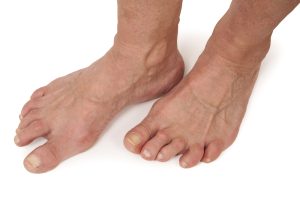Generally speaking, rheumatoid arthritis of the foot accounts for a significant portion of foot deformities. This inflammatory arthritis affects multiple joints of the feet such as the metatarsophalangeal joints, which are carrying most of the load from the body weight.
As a result, the forefoot is painful and stiff. On examination it is tender when applying transverse pressure across the foot. In addition, the hind foot can also be a cause of foot pain from arthritis and joint inflammation in the subtalar joint.
On top of this the tendon sheaths around the ankle area can also get inflamed (“ankle synovitis”), which equally leads to more foot pain, ankle pain and joint stiffness. With chronic rheumatoid arthritis eventually grotesque deformities of the forefoot and also of the toes occur, which often require some surgical treatment and/or orthotic shoes. The diagnosis of rheumatoid arthritis of the foot is based on a blood test that is positive for rheumatoid factor as well as characteristic X-ray images as mentioned in the “rheumatoid arthritis” page.
Treatment
Notably, a multidisciplinary team consisting of a physician, surgeon, podiatrist, occupational therapist and physiotherapist will be the best approach to treat the patient. First of all, a podiatrist takes care of calluses, corns or ingrowing toenails. Second, orthotic devices can take the pressure away from inflamed areas and help to make the gait healthier. These changes can lead to better tissue viability, joint mobility and improvements of circulation. Third, anti-inflammatories can help with joint inflammation and synovitis. Furthermore, a surgeon can help with foot deformities, but the surgeon should use the least invasive procedure that will alleviate the patient’s foot pain (Ref. 1, p.23).
Alternative treatment for rheumatoid arthritis
Many of the anti-aging physicians in Ref. 8 point out that rheumatoid arthritis is not only an inflammation of the joints, but is coupled with toxic substances such as heavy metals that have accumulated over a long period of time. For this reason intravenous chelation therapy has a place in removing toxic substances. In addition Ref. 8 points out that hormone rebalancing may be required. To put it another way, special blood tests are done by an anti-aging physician who is knowledgeable in bioidentical hormone replacement. With this in mind, there often are hormone deficits associated with rheumatoid arthritis, such as hypothyroidism, but also lack of estrogen, progesterone and testosterone as well as human growth hormone (evidenced by low IGF-1 levels). To clarify, detailed investigations regarding this are required and specific hormone replacement with bio-identical hormones to remedy deficits. Consequently, often even chronic cases of rheumatoid arthritis will heal.
References
1. ABC of rheumatology, second edition, edited by Michael L. Snaith , M.D., BMJ Books, 1999. Chapter 5.
2. The Merck Manual, 7th edition, by M. H. Beers et al., Whitehouse Station, N.J., 1999. Chapter 270.
3. Wheeless’ Textbook of Orthopaedics: http://www.wheelessonline.com/
4. The Merck Manual, 7th edition, by M. H. Beers et al., Whitehouse Station, N.J., 1999. Chapter 60, p.487.
5. Goldman: Cecil Textbook of Medicine, 21st ed.(©2000)W.B.Saunders
6. Ferri: Ferri’s Clinical Advisor: Instant Diagnosis and Treatment, 2004 ed., Copyright © 2004 Mosby, Inc.
7. Rakel: Conn’s Current Therapy 2004, 56th ed., Copyright © 2004 Elsevier
8. Suzanne Somers: “Breakthrough” Eight Steps to Wellness– Life-altering Secrets from Today’s Cutting-edge Doctors”, Crown Publishers, 2008







